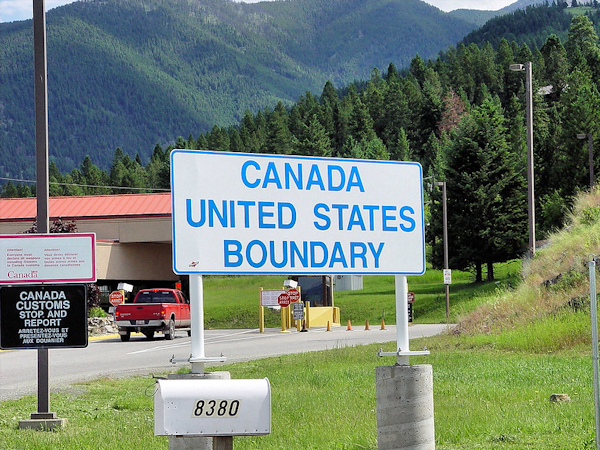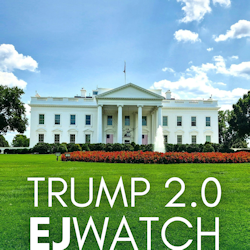SEJournal Online is the digital news magazine of the Society of Environmental Journalists. Learn more about SEJournal Online, including submission, subscription and advertising information.
 |
 |
| Natural resources and trade are integral to the decades-old environmental symbiosis between the United States and Canada. Above, the border crossing north of Eureka, Montana. Photo: Spend A Day Touring via Flickr Creative Commons (CC BY-SA 2.0). |
Backgrounder Analysis: Trump Tariffs Blow Up Long U.S.-Canada Environmental Partnership
By Joseph A. Davis
No, Canada will likely never be the “51st state” that President Donald Trump hopes for. And no, any deal any nation may reach with Trump is probably not worth the paper it is written on.
The trade war Trump is kindling will, of course, hurt U.S. consumers most. But it will also grievously damage the decades-old environmental partnership — and symbiosis — between the U.S. and the sovereign state of Canada. It’s a long and complex story we can only outline here.
Natural resources and trade are the gist of it. Also, a substantial history of being friendly neighbors. We are all North Americans. Not all of us seek to conquer the world.
Timber, oil, auto manufacture, water, shipping,
fisheries … and even maple syrup are only
part of it. The whole U.S.-Canada
relationship is environmental.
Timber, oil, auto manufacture, water, shipping, fisheries … and even maple syrup are only part of it. (Factoid: Canada is the only nation with a strategic maple syrup reserve. Even Trumpians eat pancakes. Canadians may eat more.) And for the record: Canadians died fighting the U.S.-led war in Afghanistan.
And the whole U.S.-Canada relationship is environmental. We have treaties about water, sewage, air, etc. Blowing up our treaties will blow up our neighborly relationship, not to mention a military ally.
Canadian Prime Minister Mark Carney said Trump’s tariffs mean the former military and trade relationship “is over.”
Best trade deal ever
Some observers thought this issue was done during the first Trump administration. He signed, with fanfare and hullabaloo, the U.S.-Mexico-Canada trade agreement. The USMCA updated and replaced the North American Free Trade Agreement — which Trump called a “nightmare,” if only because it wasn’t his idea.
”The USMCA is the fairest, most balanced, and beneficial trade agreement we have ever signed into law,” Trump said at the January 2020 signing ceremony. The whole point of it was free trade and minimal tariffs. It covered most of the vast trade between the three partners.
What a difference four years make. Trump's new tariff proposals would unilaterally undo much of the USMCA. Even if we are not sure what he would do, because he changes his mind so often.
“For all intents and purposes, a 25% tariff across the board would essentially suspend the USMCA,” former Mexico top negotiator Kenneth Smith Ramos told NPR.
And it must be said: Trump’s weaving on tariffs may be a negotiating strategy. Ask this: negotiating what?
North American trade is a big deal for
both countries. That much we know.
Once the trade debate starts, our
grip on exact numbers could falter.
North American trade, especially U.S.-Canada trade, is a big deal for both countries. That much we know. Once the trade debate starts, our grip on exact numbers could falter. But we do have a clue.
There was a time, 2023 to be exact, when the U.S. and Canada were each other’s top trading partners. No more.
With Trump’s flip-floppy inconsistency on tariff announcements, the whole thing may indeed be a bluff. We don’t know. But we do know that negotiations to renew the USMCA had been expected to start in 2026. And we do know that Trump and Carney had a phone call March 28 that Trump called “extremely productive.”
Canada as major U.S. oil import source
Despite all the oil industry’s eternal and misleading rhetoric about “dependence on foreign oil,” the biggest sources of U.S. oil imports are our continental homeys, Canada and Mexico.
 |
The problem is that a lot of the Canadian oil is dirty and even dangerous.
A good portion of the oil the United States gets from Canada comes from tar sands in northern Alberta. That’s the dirty part. Huge areas are essentially excavated, and the sand is removed on-site — yielding a thick and tarry goop called bitumen, which has to be diluted with solvents like naphtha before it can be shipped either by pipeline or oil train.
What’s left behind is a vast, toxic mess that pollutes water.
Sadly, this diluted bitumen, or dilbit, is more flammable than conventional crude. The 2013 fire that incinerated the town of Lac-Mégantic in Quebec … that was dilbit. The 2010 million-gallon pipeline spill that fouled Michigan’s Kalamazoo River … that was dilbit, too. A team from Inside Climate News won a Pulitzer for reporting it.
The shipping routes that bring Canadian oil to the U.S., whether by rail or pipeline, have to cross the border somewhere. That raises many permitting issues, including native tribes’ rights to land and water.
The 2016-17 protests over the Dakota Access Pipeline crossing Standing Rock Lakota Sioux treaty waters galvanized and unified Native American tribes across the United States. The permit was not issued, but it is still being litigated, partly as a defamation case.
Timber trade tussles
People in both nations still like to build houses out of wood. Wood construction is a mature technology and may keep costs down. But there are still many techniques for making wood-frame buildings more wildfire-resilient. Think metal roofs, brush clearing, etc. Not to mention mineral siding.
The trade in wood products goes both ways across the U.S.-Canada border. If we take softwood (fir, spruce, cedar) and hardwood products (oak, maple, walnut) together, here’s the score, according to the U.S. International Trade Commission (may require subscription). In 2021, the latest year available, Canada sold $28 billion worth of lumber to the U.S. and the U.S. sold $10 billion worth to Canada.
There has been serious conflict between the U.S. and Canada over softwood lumber prices going back at least to 1982. The U.S. claim was that Canadian prices were subsidized and thus too low. It was a very complex dispute — more than we can detail here.
It ultimately went up to both NAFTA and the World Trade Organization. It involved tariffs sought by the United States. It seemed to be resolved by the U.S.-Canadian Softwood Lumber Agreement of 2006. But it wasn’t. The two nations revised that agreement three more times. Right now, it’s a free market. But the issue could come up again.
Bottom line: It’s about money. But there is a raft (pun intended) of environmental issues in the background. Old growth (better for carbon storage) or second growth? Wildlife habitat (barred owl vs. endangered northern spotted owl)? Government-owned timber vs. privately owned? Indigenous and First Nation land and subsistence rights. For some, it’s about outdoor recreation or nature study.
Water, shared for better and worse
The Great Lakes, containing one-fifth of the world’s liquid, above-ground fresh water, are shared by the United States and Canada. That in itself is a governmental near-miracle. The Great Lakes were part of the water route French fur traders used to explore the continent.
They are all hydrologically connected. That means they provide an economically vital shipping route tying together regional economies. Iron ore (taconite) mined from remote surface mines is shipped via long bulk carriers from Minnesota ports like Duluth to steel mills along the lakes’ southern rim — from Gary, Indiana, to Erie, Pennsylvania — where coal from the Appalachians makes it into steel.
This was an economic bounty until the U.S. steel industry became obsolete. What remained is now called the “Rust Belt.”
The Great Lakes-St. Lawrence Seaway
opened Great Lakes ports to international
shipping. But it also opened the lakes
to a series of invasive critters.
After decades of politics and epic negotiations, the Great Lakes-St. Lawrence Seaway finally opened in 1959. That opened the Great Lakes ports to international shipping via a series of locks and canals. Business boomed. But it also opened the lakes to a series of invasive critters — from sea lampreys to quagga mussels — that harm the ecosystem.
U.S.-Canadian relations had been furthered by the formation in 1909 of the International Joint Commission. Under the IJC, the two nations signed the Boundary Waters Treaty, which generally covered water quantity issues. (Quick summary: Don’t even think about taking their water if you are some arid Western state.) Ultimately, the two nations signed the Great Lakes Water Quality Agreement in 1972. That’s the same year the U.S. passed the Clean Water Act.
Although improved, Great Lakes pollution issues have continued — especially as increasingly smaller concentrations of increasingly exotic chemicals like PFAS became the issue.
Invasives issues were exacerbated by the connection of the lakes with the Mississippi system, which started in 1900. It made Chicagoland a major continental shipping hub, but it also raised the threat of new invasives like the four species of Asian jumping carp. The Great Lakes have a fairly decent sport fishery (again because of introduced species like the Coho salmon).
But the commercial fishery has been declining and is relatively small. It is overseen by the binational Great Lakes Fishery Commission.
That’s all really just the beginning. But it gives a sense of the vast and important web of institutions that guard the invaluable Great Lakes system.
Few know that Canada shares a part of the Columbia River watershed with the United States as well. A lot of the connections were agreed upon under the Columbia River Treaty of 1964, which is currently under negotiations (may require subscription) to be modernized. It does not help that Trump called the Columbia system a “large faucet” and paused the negotiations.
We can only hint here at the very biggest binational issue: the sprawling chain of auto manufacturers, parts suppliers and assembly operations that help both nations prosper. It’s an integrated and collaborative system, beneficial to both nations.
It remains to be seen whether Trump will wreck that. Trump tariffs could choke the traffic crossing the boundary across the Ambassador Bridge between Detroit and Windsor (live cams here). Will the auto industry be the victim? The U.S. and Canadian people?
Joseph A. Davis is a freelance writer/editor in Washington, D.C. who has been writing about the environment since 1976. He writes SEJournal Online's TipSheet, Reporter's Toolbox and Issue Backgrounder, and curates SEJ's weekday news headlines service EJToday and @EJTodayNews. Davis also directs SEJ's Freedom of Information Project and writes the WatchDog opinion column.
* From the weekly news magazine SEJournal Online, Vol. 10, No. 16. Content from each new issue of SEJournal Online is available to the public via the SEJournal Online main page. Subscribe to the e-newsletter here. And see past issues of the SEJournal archived here.













 Advertisement
Advertisement 



